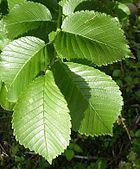Cultivar 'Clusius' | ||
 | ||
Hybrid parentage ('Exoniensis' × U. wallichiana) × 'Bea Schwarz' selfed Similar Ulmus 'Plinio', Ulmus 'Plantyn', Ulmus 'Dodoens', Ulmus minor 'Purpurascens', Ulmus parvifolia 'King's Ch | ||
Ulmus 'Clusius' is a Dutch hybrid elm cultivar raised at Wageningen and released to commerce in 1983. 'Clusius' was derived from a crossing of the same Dutch clones that produced the fastigiate 'Lobel' released in 1973: '202' ('Exoniensis' × U. wallichiana) and '336' ('Bea Schwarz' selfed).
Contents
Description
The tree has a broader crown than its siblings', whilst the generally obovate leaves, < 11 cm long by 7 cm wide, are less acuminate at the apex. Like 'Lobel', the tree flushes markedly later than most other elms, and is rarely in full leaf before mid-May.
Pests and diseases
Whilst the resistance of 'Clusius' to Dutch elm disease proved marginally greater than that of its Dutch predecessors, rated 4 out of 5, it has been eclipsed by later developments such as Lutèce. Consequently, sales in the Netherlands declined from over 8,000 in 1979 to 600 in 2004 [1].
Cultivation
While 'Clusius' remains for sale in Europe, its planting where the disease remains prevalent cannot be recommended. 'Clusius' featured in New Zealand government trials during the 1990s at the Hortresearch station, Palmerston North, but is not known to have been introduced to North America.
Etymology
The cultivar is named for Carolus Clusius, a Dutch naturalist of the Renaissance.
